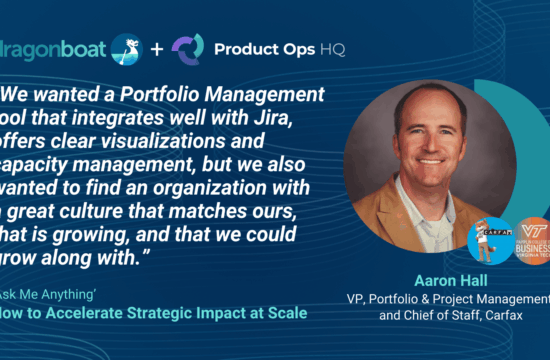There is one significant difference between a Product Manager and a Product Portfolio Manager. You might think it’s related to managing a single product area versus multiple areas and products. That’s partially true, but the real difference comes down to the organization’s mindset, operations, and strategy. Below, I explain the difference between product management and portfolio management, so you can decide what is right for you.
Let’s start with simple definitions.
What is Product Management?
Product management is the practice of managing a product throughout its lifecycle, from ideation to product development and through sunset, ensuring that it meets customer requirements and supports company goals. Product Managers typically identify customer needs, align those needs with business objectives, define the “what” and “why” behind new product features the team will build, and manage their product roadmap.
In other words, Product Managers assume responsibility for individual products. They determine what initiatives are necessary and possible, then collaborate with others in your organization to meet product-related deadlines.
What is Product Portfolio Management?
Product Portfolio Managers take a broader, more holistic view—overseeing all aspects of the product(s) the organization sells. For example, Product Portfolio Manager (PPM) responsibilities include identifying opportunities and risks across the entire portfolio, optimizing resource allocation, and switching from feature roadmapping to outcome-driven OKR roadmaps.
At its core, Product Portfolio Management guides the collective efforts across the entire product org toward higher-level company goals. It works closely with all team members to connect objectives, products, and resources with execution.
What Type of Companies Hire a Product Portfolio Manager?
Whether they have one product or several, companies need a Product Portfolio Manager if they take a portfolio approach to their decision-making across multiple product goals, themes, timeframes, user groups, regions, etc.
As companies scale, they need portfolio-minded leaders to be the internal strategic driver. Portfolio management focuses all product areas, products, and their teams on top-level strategies to accelerate business outcomes.
In some companies that have product operations, the activities of product portfolio management may fall under the scope of the Product Operations Manager or Director since both PPMs and Product Ops exist to drive product portfolio outcomes.
Ready to scale your Product Management skills to Product Portfolio Management? Watch this webinar recording to hear from industry experts on incorporating the framework into your organization.
Can You Have a Product Portfolio Manager With A Single Product?
Yes! Even with one product, you can manage it as a “one-product portfolio” since it most likely has multiple facets, use cases, and markets. You also may have to balance customer needs, product vision, and business goals when making trade-offs and prioritization decisions.
For example, Gmail by Google is a one-product portfolio. Within the Gmail product team, there are many product managers, and each is involved in building a different facet of Gmail within the company’s overall product portfolio (e.g., the mobile app, desktop app, ads, smart recommendations, etc.).
Another way to think about it is that every touchpoint where a customer interacts with your product, service, customer support, or brand is a product. Your website is a product. Your integration ecosystem is another product with its teams, delivery cadences, and features. Your internal systems are a product. You get the idea.
Why Should You Care About Product Portfolio Management?
Some of the most successful companies practice Product Portfolio Management, including Paypal, Chime, and Miro, just to name a few. Companies that put Product Portfolio Management into practice have consistently increased revenues while reducing costs with more efficient resource allocation, deliberately investing in more impactful projects, and overall improved internal efficiencies.
How to Get Started as a Product Portfolio Manager
The best Product Portfolio Managers start with the corporate-wide business goals and identify where to invest time and resources across the portfolio to achieve meaningful results. It takes progressive and strategic thinkers to view all business areas as interconnected products. Next, you set objectives that span multiple products or areas of the business and link them to the corporate strategy. Many teams connect objectives and key results (OKRs) to their initiatives and roadmaps.
By linking these, an outcome-driven organization prioritizes initiatives for the relevant OKRs based on how much they contribute to each objective. This framework guides teams to prioritize what to build next while keeping the organization aligned through planning, resourcing, tracking, and communicating. Many use a Responsive Product Portfolio tool to facilitate this process, guide best practices, and rally all stakeholders to achieve team and company-wide OKRs.
What is the Difference Between Product Management and Portfolio Management?
To summarize, product management is responsible for a product throughout its lifecycle and focuses on aligning customer needs with business goals. Product portfolio management takes the big picture view. It aims to optimize your portfolio of products to drive efficiencies and positive business outcomes, such as increasing market share, encouraging adoption, or growing revenue.
Both roles are cross-functional. They interact with colleagues across the organization, from project managers to customer success and even the executive team. So, although the position certainly requires technical expertise, those who are successful are also highly organized individuals with strong interpersonal and communication skills.
Difference Between Product Management and Portfolio Management
| Product Management | Product Portfolio Management | |
| Scope of Role | Individual products or services | Portfolios of products or services |
| Primary Focus | Aligning customer needs with business goals throughout an individual product’s lifecycle and driving execution of product-related initiatives. | Optimizing a collection of products (a portfolio) to drive efficiencies and maximize positive business outcomes. |
| Time-Horizon | Short-to-mid term | Short-to-long term |
| Measurement | Product centric | Portfolio centric |
Learn More About Product Portfolio Management
Are you interested in learning more or leveling up your skills in Product Portfolio Management? Sign up for our free Responsive Product Portfolio Management training!
Categories
Product Leadership | Product Management | Product Operations | Product Portfolio Management
Share on Social



